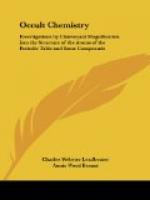ZIRCONIUM (Plate XV, 2, 5).
Zirconium reproduces in its c the four forms that we have already followed in the corresponding c of titanium, and as these are set free on the proto level, and follow the same course on the meta and hyper levels, we need not repeat them. The central globe of zirconium c sets free its nine contained bodies; eight of these are similar and are figured in the diagram; it will be observed that the central body is the truncated “cigar” of carbon; their behaviour on the meta and hyper levels is easily followed there. The central sphere is also figured; the cigar follows its usual course, and its companions unite into a sextet and an octet. The d ovoid liberates five bodies, four of which we have already seen in titanium, as the crosses and sextet of sodium, and which are figured under titanium; the four quartets within the larger globe also follow a sodium model, and are given again.
SILICON (Plate XVI, 1).
[Illustration]
In silicon, the ovoids are set free from the funnels on the proto level, and the truncated “cigar,” playing the part of a leaf, is also liberated. This, and the four “cigars,” which escape from their ovoids, pass along their usual course. The quintet and quartet remain together, and form a nine-atomed body on the meta level, yielding a sextet and a triplet on the hyper.
GERMANIUM (Plate XVI, 2, 4).
The central globe, with its two “cigar"-bearing tetrahedra, need not delay us; the tetrahedra are set free and follow the occultum disintegration, and the central four atoms is the sodium cross that we had in titanium. The ovoids (XVI, 4) are liberated on the proto level, and the “cigar,” as usual, bursts its way through and goes along its accustomed path. The others remain linked on the meta level, and break up into two triangles and a quintet on the hyper.
TIN (Plate XVI, 3, 4).
Here we have only the spike to consider, as the funnels are the same as in germanium, and the central globe is that of titanium, omitting the eight atomed centre. The cone of the spike we have had in silver (see p. 729, May), and it is set free on the proto level. The spike, as in zinc, becomes a large sphere, with the single septet in the centre, the remaining six bodies circling round it on differing planes. They break up as shown. (Tin is Sn.)
IRON (Plate IV, I, and XVII, 3).
[Illustration]
We have already dealt with the affinities of this peculiar group, and we shall see, in the disintegration, even more clearly, the close relationships which exist according to the classification which we here follow.
The fourteen bars of iron break asunder on the proto level, and each sets free its contents—a cone and three ovoids, which as usual, become spheres. The twenty-eight-atomed cone becomes a four-sided figure, and the ovoids show crystalline contents. They break up, on the meta level as shown in the diagram, and are all reduced to triplets and duads on the hyper level.




